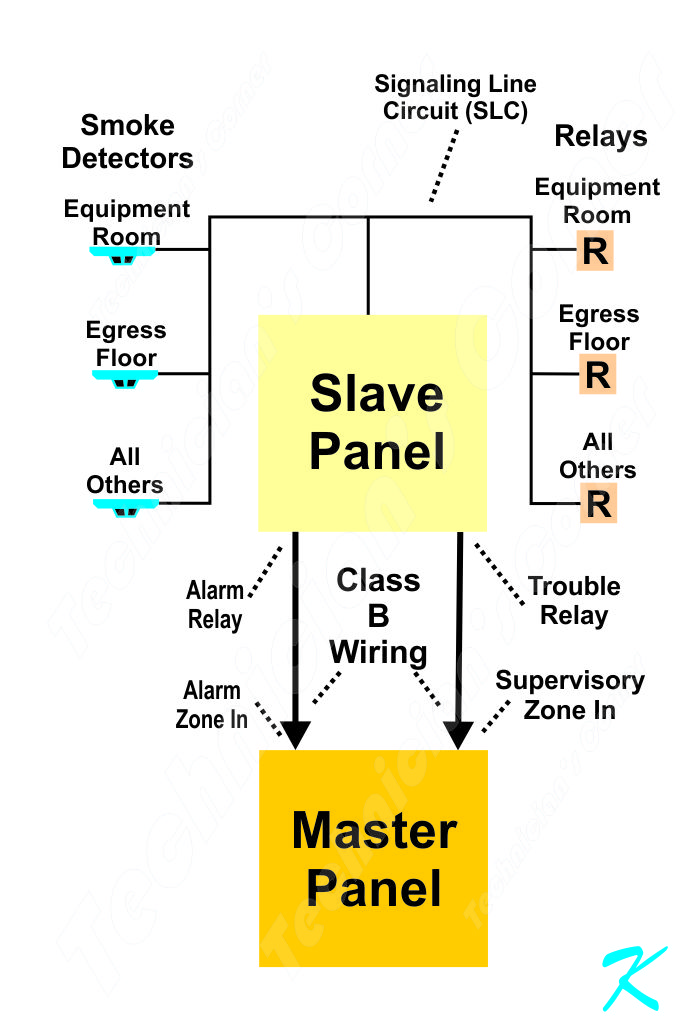The system will be set up as the conventional panel being the master fire alarm panel, and the addressable panel, being the elevator capture panel, as the slave panel.
Elevator Capture
This would be the setup of the addressable panel. On the slave panel, the elevator capture system is operated with 3 Non-supervised Relay Output Modules on the Signaling Line Circuit (SLC). These are for:
- The egress floor smoke detector (the smoke detector located on the primary floor)
- The elevator machine room smoke detector
- All other smoke detectors
These control relays should be mounted inside the elevator equipment room, within a couple of feet from the elevator control box. Remember that all wiring within the elevator equipment room has to meet the requirements of not just the National Electrical Code (NEC) and the NFPA 72 Code, but also any extra codes for the elevator system.
Programming would have these relays turned on by the appropriate smoke detectors. The exact programming is different from one elevator manufacturer to another, so check with the elevator company to make sure that the programming for the relays.
All smoke detectors are usually alarm, not supervisory, and all elevator capture smoke detectors have to be reset at the slave panel. An extra step in the normal reset process is that any alarms on the slave panel have to be reset before the master panel can be reset. When an elevator capture smoke detector goes into alarm, the owner will have to be instructed to reset the elevator capture panel before resetting the main fire alarm panel, or the fire department may be called again. With two panels, two resets in the proper order can't be helped. Instructions for this procedure should be mounted on both panels.
Connections between Slave and Master Panels
There are two signals from the slave panel that are required: Alarm and Trouble. The conventional master panel requires two currently empty zone inputs: Alarm and Supervisory. Trouble on the output of the slave panel is a supervisory input to the master panel. A way of thinking about that is that the master panel is "supervising" the "troubles" of the slave panel.
Slave Trouble is Master Supervisory
Trouble has to be hard wired from the slave panel to the master panel because if the slave panel completely fails, a trouble has to be sent to the master panel anyway.
Using Class B circuitry, connect the trouble relay contacts on the slave panel's main circuit board (Common, Normally Open, Normally Closed) as if they were a sprinkler tamper switch.
Connect this to one of the spare zone inputs on the master panel. Then program the zone as a supervisory zone and label the input zone on the master panel as trouble on the elevator capture panel.
Alarm on Slave Panel is Alarm on Master Panel
Alarms from the smoke detectors should also be hard wired from the slave panel to the master panel. Use the alarm contacts on the slave panel (Common, Normally Open, Normally Closed) as if they were a waterflow switch or a pull station, and connect the alarm contacts to the other zone input on the master panel. Program this on the master panel as a full alarm and label the zone as an alarm on an elevator smoke detector.
Both input zones require end of line resistors. The end of line resistors are required to be at the end of the line, inside the slave panel, and both have to be wired as normal, conventional Class B wiring.
When one of the addressable smoke detectors goes into alarm and the fire department arrives, because an elevator smoke detector will be an alarm in one of several smoke zones, there will have to be labeling on the master panel to indicate this so the firefighters will look in the proper elevator lobby or the machine room. (I have found an elevator machine room full of smoke hours after the fire department left. The firefighters they didn't check the elevator machine room because they thought it was a false alarm. Make sure the equipment room is on the label, as well as the elevator lobbies.)
Alternate: Alarm on Slave Panel is Supervisory on Master Panel
Yes, there are some jurisdictions (like some states in the U. S.) that allow elevator capture devices to be supervisory instead of alarm.
If the elevator capture smoke detectors are going to be supervisory, the elevator capture slave panel still has to treat the detectors as if they were alarm devices. Just keep in mind that any supervisory signal in any fire alarm system is really a type of alarm; activating a fire system into supervisory just isn't as loud as activating a fire system into alarm.
Connect the alarm relay contacts on the slave panel's main circuit board (Common, Normally Open, Normally Closed) as if they were a waterflow switch.
Connect this to one of the spare zone inputs on the master panel. Then program the zone as a supervisory zone and label the zone on the master panel as a supervisory alarm on the elevator capture panel.
Pre-Test the System
If you want to save time and effort, perform pre-tests; make sure the system works before elevator inspection time.
Before connecting the elevator capture slave panel to the master panel, or even the elevator control box, test the smoke detectors with smoke to make sure they work. Using an ohmmeter, check the contacts of the capture control relays to make sure the appropriate relay(s) activate with the smoke test.
When this test shows everything is working, wire up the systems and perform a full test with the elevator company present. Make sure that smoke applied to each smoke detector will capture the elevator to the correct floor.
Perform the pre-tests exactly that way that the elevator inspector is going to perform the tests. That way, the inspector's final test will be a formality.
Douglas Krantz
